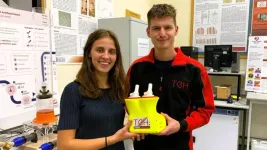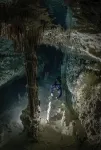(Press-News.org) Deep within every piece of magnetic material, electrons dance to the invisible tune of quantum mechanics. Their spins, akin to tiny atomic tops, dictate the magnetic behavior of the material they inhabit. This microscopic ballet is the cornerstone of magnetic phenomena, and it's these spins that a team of JILA researchers—headed by JILA Fellows and University of Colorado Boulder professors Margaret Murnane and Henry Kapteyn—has learned to control with remarkable precision, potentially redefining the future of electronics and data storage.
In a new Science Advances publication, the JILA team—along with collaborators from universities in Sweden, Greece, and Germany—probed the spin dynamics within a special material known as a Heusler compound: a mixture of metals that behaves like a single magnetic material. For this study, the researchers utilized a compound of cobalt, manganese, and gallium, which behaved as a conductor for electrons whose spins were aligned upwards and as an insulator for electrons whose spins were aligned downwards.
Using a form of light called extreme ultraviolet high-harmonic generation (EUV HHG) as a probe, the researchers could track the re-orientations of the spins inside the compound after exciting it with a femtosecond laser, which caused the sample to change its magnetic properties. The key to accurately interpreting the spin re-orientations was the ability to tune the color of the EUV HHG probe light.
“In the past, people haven't done this color tuning of HHG,” explained co-first author and JILA graduate student Sinéad Ryan. “Usually, scientists only measured the signal at a few different colors, maybe one or two per magnetic element at most.” In a monumental first, the JILA team tuned their EUV HHG light probe across the magnetic resonances of each element within the compound to track the spin changes with a precision down to femtoseconds (a quadrillionth of a second).
“On top of that, we also changed the laser excitation fluence, so we were changing how much power we used to manipulate the spins,” Ryan elaborated, highlighting that that step was also an experimental first for this type of research.
Along with their novel approach, the researchers collaborated with theorist and co-first author Mohamed Elhanoty of Uppsala University, who visited JILA, to compare theoretical models of spin changes to their experimental data. Their results showed strong correspondence between data and theory. “We felt that we'd set a new standard with the agreement between the theory and the experiment,” added Ryan.
Fine Tuning Light Energy
To dive into the spin dynamics of their Heusler compound, the researchers brought an innovative tool to the table: extreme ultraviolet high-harmonic probes. To produce the probes, the researchers focused 800-nanometer laser light into a tube filled with neon gas, where the laser's electric field pulled the electrons away from their atoms and then pushed them back. When the electrons snapped back, they acted like rubber bands released after being stretched, creating purple bursts of light at a higher frequency (and energy) than the laser that kicked them out. Ryan tuned these bursts to resonate with the energies of the cobalt and the manganese within the sample, measuring element-specific spin dynamics and magnetic behaviors within the material that the team could further manipulate.
A Competition of Spin Effects
From their experiment, the researchers found that by tuning the power of the excitation laser and the color (or the photon energy) of their HHG probe, they could determine which spin effects were dominant at different times within their compound. They compared their measurements to a complex computational model called time-dependent density functional theory (TD-DFT). This model predicts how a cloud of electrons in a material will evolve from moment to moment when exposed to various inputs.
Using the TD-DFT framework, Elhanoty found agreement between the model and the experimental data due to three competing spin effects within the Heusler compound. “What he found in the theory was that the spin flips were quite dominant on early timescales, and then the spin transfers became more dominant,” explained Ryan. “Then, as time progressed, more de-magnetization effects take over, and the sample de-magnetizes.”
The phenomena of spin flips happen within one element in the sample as the spins shift their orientation from up to down and vice versa. In contrast, spin transfers happen within multiple elements, in this case, the cobalt and manganese, as they transfer spins between each other, causing each material to become more or less magnetic as time progresses.
Understanding which effects were dominant at which energy levels and times allowed the researchers to understand better how spins could be manipulated to give materials more powerful magnetic and electronic properties.
“There’s this concept of spintronics, which takes the electronics that we currently have, and instead of using only the electron’s charge, we also use the electron’s spin,” elaborated Ryan. “So, spintronics also have a magnetic component. The reason to use spin instead of electronic charge is that it could create devices with less resistance and less thermal heating, making devices faster and more efficient.”
From their work with Elhanoty and their other collaborators, the JILA team gained a deeper insight into spin dynamics within Heusler compounds. Ryan said: “It was really rewarding to see such a good agreement with the theory and experiment when it came from this really close and productive collaboration as well.” The JILA researchers are hopeful to continue this collaboration in studying other compounds to understand better how light can be used to manipulate spin patterns.
END
Unlocking the secrets of spin with high-harmonic probes
2023-11-10
ELSE PRESS RELEASES FROM THIS DATE:
University of Minnesota Medical School researchers investigate cause of cardiomyopathy in coronary artery disease using cardiac MRI
2023-11-10
MINNEAPOLIS/ST. PAUL (11/10/2023) — Researchers from the University of Minnesota Medical School examining the cause of cardiomyopathy discovered one out of every six patients with coronary artery disease had non-ischemic or dual cardiomyopathy.
The findings of this study were published this week in the peer-reviewed journal Circulation, the flagship journal of the American Heart Association.
Cardiomyopathies are diseases of the heart muscle. Patients with coronary artery disease can have cardiomyopathy from heart muscle ...
Heart of Gold: Bath student team wins world Heart Hackathon competition
2023-11-10
Student engineers from the University of Bath are on top of the world after winning an international competition to design an artificial heart.
Team Bath Heart took top prize at the grand final of the first-ever Heart Hackathon, which was held in Texas at the end of October.
Six members of the team presented their device to global experts in artificial heart technologies, competing against teams from Australia, the United States, Sweden, New Zealand, Romania and Egypt.
The ‘total artificial heart’ ...
Cleveland Clinic research links sleep apnea to increased risk of atrial fibrillation
2023-11-10
New research from Cleveland Clinic has identified a link between sleep apnea and the development of atrial fibrillation, a common heart rhythm disorder.
Published in JAHA, the study of over 42,000 patients found that sleep-related hypoxia - or low oxygen levels during sleep - is associated with a higher risk of developing atrial fibrillation over time. The study found this risk persisted even after accounting for lung function, suggesting sleep-related hypoxia independently increases atrial fibrillation risk separate from any underlying lung disease.
Atrial fibrillation causes an irregular ...
New approach to pancreatic cancer treatment expands therapeutic possibilities, shows promise for increased survival
2023-11-10
Preclinical research published in the Journal for ImmunoTherapy of Cancer points to a promising new treatment option for people with pancreatic cancer. Researchers from VCU Massey Comprehensive Cancer Center and the VCU Institute of Molecular Medicine (VIMM) suggest that when used in a form that can be delivered directly into the tumor cell, polyinosine–polycytidylic acid (pIC) suppresses tumor growth, induces cancer cell death and enhances survival in animal models with the most common form of pancreatic cancer.
Researchers also concluded that when used alone ...
UTHealth Houston partners with Mexican organizations for $5 million NIH grant to improve implementation of cancer control interventions in Mexico and Latin America
2023-11-10
A five-year, $5 million grant has been awarded by the National Cancer Institute (NCI) to the UTHealth Houston Institute for Implementation Science to support research and training in implementation science, with a focus on improving cancer control efforts in Mexico and Latin America.
The grant brings together researchers from UTHealth Houston, the Mexican National Institute of Public Health (INSP), the Mexican National Cancer Institute (INCan), and the University of California San Francisco (UCSF).
The grant will fund a new center, LISTOS for Cancer Control – Leveraging Implementation ...
Yucatán’s underwater caves host diverse microbial communities
2023-11-10
Cave divers collected 78 water samples throughout the complex web of underwater caves
Researchers found the cave system’s microbiome is distinct from the nearby sea
Microbial communities vary between cave systems forming distinct “neighborhoods”
EVANSTON, Ill. — With help from an experienced underwater cave-diving team, Northwestern University researchers have constructed the most complete map to date of the microbial communities living in the submerged labyrinths beneath Mexico’s Yucatán Peninsula.
Although previous researchers have collected water and microbial samples from the ...
A catalyst for change: New research aims to design atomically efficient and selective catalysts
2023-11-10
Most of us understand that electrical engineering and mechanical engineering play a key role in running our washing machines or our computers. But did you know that more than 80 percent of the products we use every day, such as fertilizers, cosmetics, fragrances, rubber and more, require some sort of chemical catalyst while being manufactured?
Catalysts are like turbochargers for chemical reactions. Until now, the process of designing a catalyst for chemical reactions has been mostly trial ...
Study finds tapering TNF inhibitors increases flares, lowers boolean remission rates for RA patients in remission
2023-11-10
ATLANTA — New research at ACR Convergence 2023, the American College of Rheumatology’s (ACR) annual meeting, found that rheumatoid arthritis (RA) patients in sustained remission who stopped TNF inhibitors (TNFi) had significantly more flares and lower Boolean 2.0 remission rates compared with those who continued treatment. Boolean 2.0 is a revised definition for evaluating disease activity in RA that classifies more patients as achieving remission than Boolean 1.0. It is endorsed by the American College of Rheumatology and the European Alliance for Associations in Rheumatology (EULAR) (Abstract #L07).
As more RA patients ...
Study shows stem cell transplant significantly improves outcomes in refractory juvenile systemic sclerosis
2023-11-10
ATLANTA — New research at ACR Convergence 2023, the American College of Rheumatology’s (ACR) annual meeting, shows that patients with refractory juvenile systemic sclerosis improved significantly on nearly all measures for two years following autologous stem cell transplant (Abstract #L06).
Juvenile-onset systemic sclerosis (jSSc), also called scleroderma, is a disfiguring autoimmune disorder marked by hardening of the skin and internal organs, including the digestive tract, lungs, musculoskeletal system, kidneys and heart. The psychological and physical effects of the disease persist into adulthood, and many patients have a shortened lifespan. Effective ...
Adolescent and young adult sex workers more likely to experience muscle dysmorphia
2023-11-10
Using data from over 900 participants in a large, diverse, and national sample of Canadian adolescents and young adults from the Canadian Study of Adolescent Health Behaviors, a new study published in the journal Sexual Health researchers found significant associations between sex work and muscle dysmorphia.
Sex work, in its various forms, is highly stigmatized in Canadian society, and sex workers are often victims of harmful stereotypes. It is estimated that roughly 4% of Canadian adolescents engage in selling sex, and research has shown that those involved in sex work are more at risk to experience substance use ...


